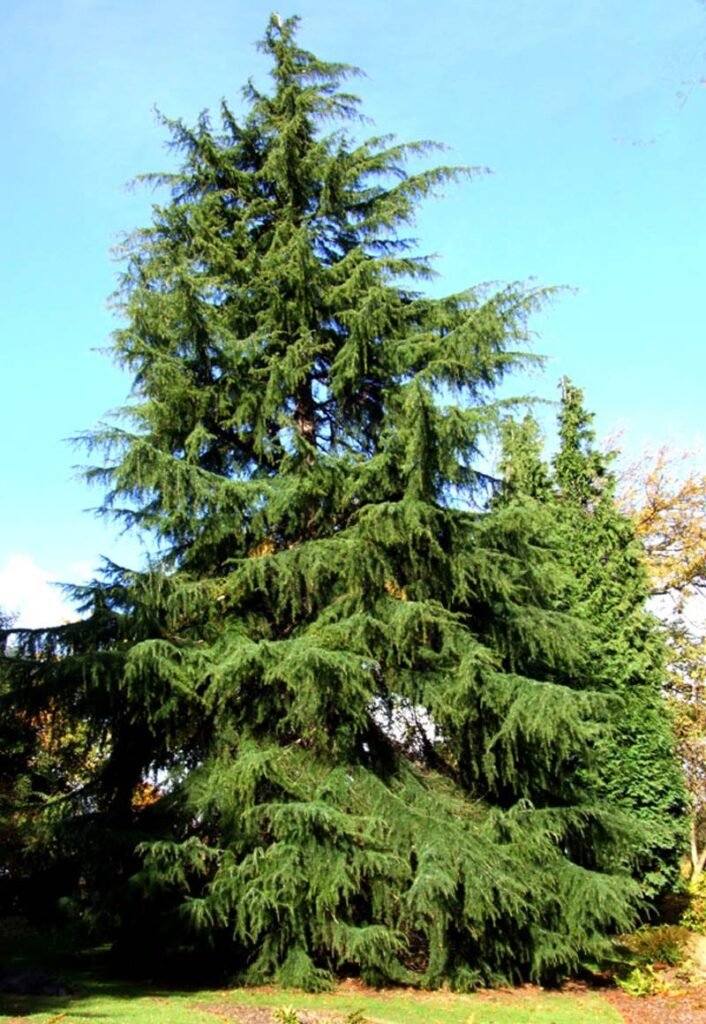
Botanical Name: Cedrus Deodara
Kingdom: Plantae
Division: Magnoliophyta
Class: Pinopsida
Order: Pinales
Family: Pinaceae
Genus: Cedrus Trew
Species: Cedrus deodara (Roxb.) G. Don f.
Popular Names: Deodar, Himalayan Cedar
Part Used: Rhizomes
Habitat: Grows wild in damp deciduous forests
Description
Cedarwood is a plant that is up to 50 m high and up to 3 m in diameter. It has the shape of a pyramid and is crown conical when young, with leader and branches drooping at the end. On the other hand, the older trees are more rounded. The branches are horizontally arranged, while the ends of the shoots are pendulous. The needles are blue-green, about 30 in a cluster, 3-5 cm long, and acuminate. Flowers appear in September and October. These plants need plenty of room to spread. Large specimens of this plant have trunks, almost 3 feet in diameter and spread across 50 feet. In India, the plant is mostly found in the western Himalayan belt, at an altitude of 3,500 to 12,000 feet. Its range extends to the Hindukush area, where it grows extensively.
Plant Chemicals
Cederwood contains essential oil, which contains p-methylacetophenone, alantone, the sesquiterpene alcohols himachalol, allohimachalol, as well as cedrol and limonene. Other constituents that have been isolated from the wood include the flavonoids deodarin, cedeodarin, cedrin, cedrinoside and quercitin, as well as the sesquiterpene, himasedone, isoprimaric acid, cedrusin, cedrusinin, matairesinol deodadione, carboxylic acid, nortrachelogenin, and a dibenzylbutyrolactollignan.
Uses and Benefits of Cedarwood
- The bark of cedarwood proves to be a good remedy in remittent and intermittent fevers, diarrhoea and dysentery. The powder is used in the treatment of ulcers.
- The inner wood of the plant is aromatic and is thus, used to make incense. The inner wood is also distilled to make essential oils.
- The essential oil obtained from this plant is used as an insect-repellant on the feet of horses, cattle and camels, as insects avoid venturing close to it.
- Cedarwood possesses anti-fugal properties and has shown limited potential in controlling fungal deterioration of species, during storage.
- The outer bark and stem of the tree are used for making astringent.
- The biomedical actions of the plant are believed to be carminative and anti-spasmodic. It creates sweating and urination.
- The Ayurvedic functions of the plant promote digestive function, remove toxins from the bowel, alleviate coughing, and cure skin disorders, such as eczema and psoriasis.
- As it possesses aromatic properties, cedar oil is often used in aromatherapy. It has a characteristic woody whiff, which can change slightly in the course of drying out.
- The resins of the herb are used as anti-obesity agent. They are also effectual in clearing the respiratory tract and reducing cough and cold.
- Cedarwood (deodar) is also used as a building material, as it is durable and rot-resistant. It has fine close grain, which can sustain high polish.
- Historically, cedarwood was used in the construction of temples and landscape around temples. The famous houseboats of Kashmir and India are also made of deodar. During the colonial era, it was extensively used for the construction of barracks, public buildings, bridges, canals and railway cars.
Caution
The essential oil from cedarwood should be used with extreme care and avoided during pregnancy, as is the case with almost all essential oils.

